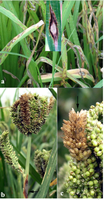Ragi Blast-a major disease in finger millet
Ragi Blast-a major disease in finger millet
Ragi (Finger millet)
Finger millet (Eleusine coracana) is a tetraploid plant species grown majorly in semi-arid regions of India and Africa. The grains of finger millet have a rich nutrient composition in terms of good quality protein, high content of fibre and a variety of minerals especially calcium. Finger millet is a hardy crop that grows in marginal lands with poor nutrient composition. It is mainly grown as a rainfed crop and is often considered as a poor man’s cereal.
Ragi Blast disease
The major limiting factor for finger millet production in the cultivated areas is the occurrence of ragi bast. Blast of finger millet was first reported in the Tanjore area of Tamil Nadu almost a century ago. The disease is reported to cause complete harvest loss if it occurs prior to grain formation. The average loss due to blast is reported to be around 28 to 36 percent.
Causal organism
Blast is a fungal disease caused by Magnaporthe grisea. The same pathogen causes the devastating blast disease of rice.
Magnaporthe grisea is an ascomycete fungus that is a biotroph and is highly diverse in nature. Even though the pathogen has a broad range of hosts among grasses and sedges, a particular strain has only a limited number of hosts.
Magnaporthe spreads as air borne conidia (asexual spores) which upon reaching an ideal host enters the cells through stomata and germinates under high relative humidity (more than 90%) and congenial temperatures (25 to 280C). Symptoms generally appear as lesions on the 4th to 5th day of conidial entry. Frequent rains and cloudy skies are congenial for the conidial germination due to high relative humidity and presence of water droplets that facilitates germination.
Symptoms
T he fungus infects in different stages of the crop leading to leaf blast, neck blast and finger blast.
he fungus infects in different stages of the crop leading to leaf blast, neck blast and finger blast.
The symptoms appear as circular lesions that are pointed towards either ends. The centre of the spots appear greyish and the borders become brownish. In susceptible genotypes, several of such spindle shaped spots coalesce together, leading to drying of the entire leaf. Resistant genotypes develop specks on the leaves and necks.
When the fungus infects the neck region, a few inches of neck just below the finger turns brownish black ultimately leading to breakage of the peduncle.
Maximum damage is caused by neck blast as it prevents grain formation or shrivelling of grains.
Disease management
The disease is controlled through cultural methods, chemical methods and also by the use of resistant varieties.
- Seed treatment with a fungicide solution before sowing is advisable as the disease is seed-borne.
- High plant density encourages blast disease development and hence needs to be avoided. The recommended spacing (30 x 15 cm) for finger millet should be followed to avoid crowding of seedlings and to ensure proper aeration.
- Excessive use of fertilizers is not recommended as a positive correlation has been identified between higher nitrogenous fertilizer dose and blast incidence. Inter-cultivation as well as crop rotation of ragi with legumes is not only economical but also helps in soil nutrient enrichment and in reducing the fungal inoculum. In the chemical control measures, application of fungicides such as edifenphos (0.1%), carbendazim (0.2%) and mancozeb (0.2%) is found to be highly effective. Use of biocontrol agents such as Pseudomonas, Bacillus and Trichoderma as field spray as well as in seed treatment has been found to be effective against controlling the fungus as per some studies. Though chemical control is effective against this disease, it is not economical to the farmers and is harmful to the environment. Development and cultivation of resistant varieties is the most ecologically sound and affordable way of combating this problem as finger millet is a crop of the marginal farmers. Some of the blast resistant finger millet varieties include GPU28 (used as resistant check in breeding trial), GPU48, GPU45, VL Mandua 348, KMR 340, BM2 and PRM. Single gene resistance often breaks down easily due to the rapid evolution of pathogen in response to selection pressure which can be overcome by incorporating multiple genes in resistance breeding. In rice, several resistance genes against Magnaporthe have been cloned and improved varieties have been developed through introgression. But the basic studies on the resistance mechanism of finger millet against blast fungus is meagre and none of the resistance genes have been identified so far.
Conclusion
Blast epidemic is a serious concern in all finger millet growing areas as the pathogen is highly variable and the build-up of inoculum of new virulent race occurs frequently. There is a necessity to understand the host-pathogen interaction in a detailed manner so that more durable resistant varieties can be generated, better management measures developed and the devastating disease can be kept in control.
Source : Jinu Jacob, Deepika Cheruku, Swarna Ronanki, ICAR-Indian Institute of Millets Research, Hyderabad
Image source : Diseases of Millets - a ready reckoner
Last Modified : 2/12/2020
This topic deals with information related to Anima...
Basic information on Malaria including symptoms, c...
Reasons for discharge from ear, symptoms and preca...
Acne causes, symptoms and remedies are described h...
